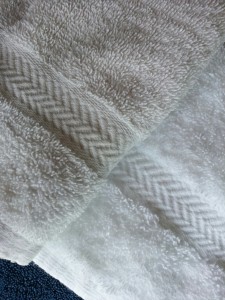 “Alright, Ms Susie Homemaker,” my mother announced near the end of our latest phone conversation, “I have a question about cleaning white washcloths. It seems no matter what I do, mine always look like I just mopped the floor with them. They never get white.” She’d even tried one of the well-known powder oxygen bleaches on the market “…but,” she continued, “It didn’t seem to make any difference at all.”
“Alright, Ms Susie Homemaker,” my mother announced near the end of our latest phone conversation, “I have a question about cleaning white washcloths. It seems no matter what I do, mine always look like I just mopped the floor with them. They never get white.” She’d even tried one of the well-known powder oxygen bleaches on the market “…but,” she continued, “It didn’t seem to make any difference at all.”
Well, she had me stumped, so I told her I’d do some investigating and get back to her. Here’s what I discovered…
Two Types of Bleaches
According to the folks at Consumer Reports (and elsewhere), there are two types of household bleaches: liquid chlorine and nonchlorine oxygen bleaches. Liquid chlorine bleaches are similar from one brand to another with about the same amount or ratio of sodium hypochlorite as an active ingredient. (Note: an active ingredient is what makes the stuff work.)
Oxygen bleaches come in powdered or liquid form. In powdered oxygen bleach, the active ingredient is sodium perborate tetrahydrate or sodium percarbonate, while for liquid oxygen bleach, the active ingredient is hydrogen peroxide. Both types of bleaches (chlorine or oxygen) work with your laundry soap or detergent to remove stains from your clothes.
What You Need to Know
Each type of bleach has its own specialty.
- Oxygen bleach is safer for more types of fabric than the chlorine bleach, but it is also weaker and is best used on a regular basis to maintain the whiteness of white fabrics or the brightness of colored fabrics.
- Chlorine bleach, on the other hand, is stronger and is usually the best choice for whitening clothes—especially if you can use hot water which improves the performance of the bleach. (This is what Mom should probably use on her washcloths.) (Check here for how to use chlorine bleach with your clothes)
Be aware that too much use of too much chlorine bleach in the wash water can damage fabric and/or fade colors (which would be annoying). Chlorine bleach is usually okay to use on linens, cottons and a few other colorfast fabrics, but play it safe and always follow the laundry directions on clothing tags.
Some Other Reasons for Not-So-White Washcloths (or Whatever)
Your white washcloths, etc., may become dingy (and the bleach you’re using will have a difficult time working):
- If you have hard water in your area. Hard water makes cleaning more difficult and can actually leave a residue on your clothes. Soft water is better for effective cleaning. If you live in a hard-water area then you’ll probably need to add a water-conditioning product to your wash water. (Check here to see if you live in a hard water area)
- If you use laundry soap instead of laundry detergent. Laundry soap works fine in soft water, but not so well in hard water. The minerals in the hard water react with the laundry soap to create a greyish film that sticks to your clothing. (Check here for Consumer Reports info on best laundry detergents)
- If you’re mixing your laundry. Your white washcloths (or whatever) will definitely become greyish if you wash them with dark jeans or other such items. Sort your laundry into different piles. White clothes get washed with white clothes. Blue or black clothes gets washed with blue or black clothes. Red, orange, and pink clothes gets washed in their own separate load. Period. (Check here for additional cleaning tips)
Remember
Use the right bleach for each type of fabric, the right laundry soap or detergent with your soft or hard water, and don’t get lazy or cheap and wash everything together in one multi-colored load. Because Mom’s right. White washcloths shouldn’t look like you just mopped the floor with them (and neither should the rest of your whatevers).
